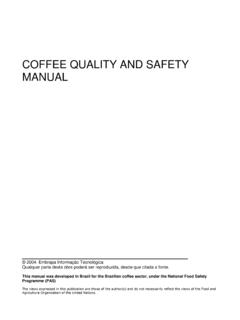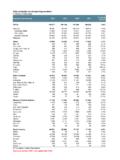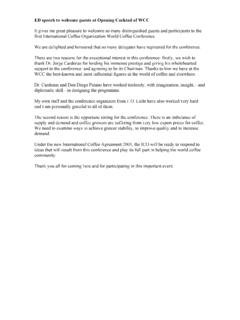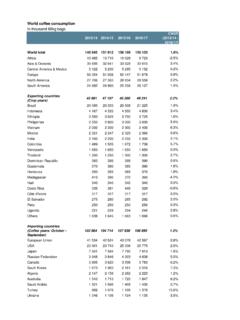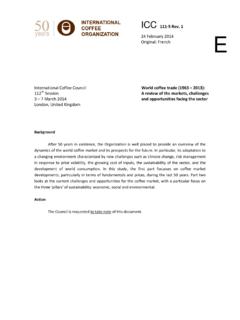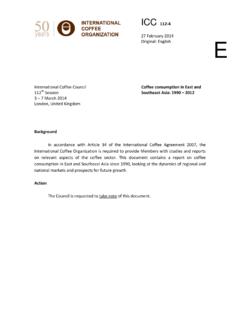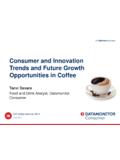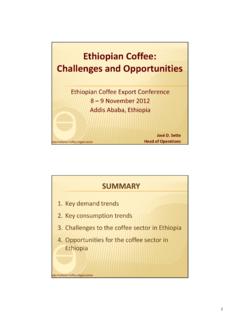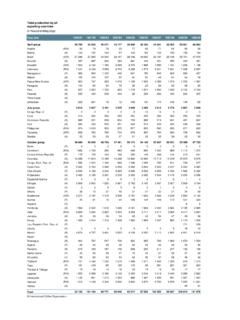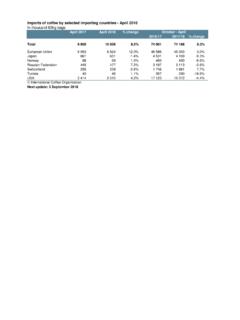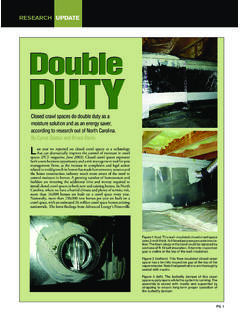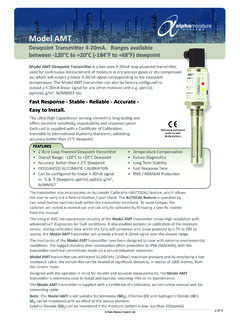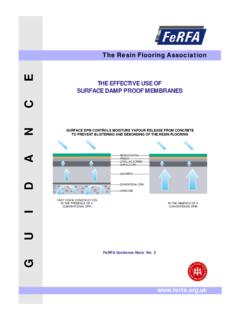Transcription of DETERMINATION OF MOISTURE CONTENT - …
1 DETERMINATION of MOISTURE CONTENT 1. Introduction: Drying, storage, marketing, and roasting are four important aspects of coffee handling in which MOISTURE plays an important role: Drying: MOISTURE measurement at the end of drying is essential to follow up drying course and to decide whether it is achieved or not. On one hand, too long a drying course may have bad consequences for quality and food safety because of unexpected fermentations and mould growth. On the other hand, the next step in the process is storage. Also, drying to a too low MOISTURE CONTENT can result in income losses - for example, a truck which weighs 1000 kg with beans at 12 % MOISTURE , will weight only 967 kg at 9 % MOISTURE ; Storage: storing coffee with too high a MOISTURE CONTENT may involve high risks of mould growth and OTA production; Marketing: a cargo of 25,000 tons of coffee at 12 % MOISTURE represents 3000 tonnes of water.
2 At %, the cargo contains 3,625 tons of water. At just $ per kg, this difference is worth $125,000; Roasting: temperature and length of roasting are adjusted to a usual MOISTURE of 12 % to 13 %. Above these values, roasting requires more energy and might be incomplete. Below these values, beans might end up being over-roasted. 2. Methods of Measuring MOISTURE CONTENT : The methods of determining MOISTURE CONTENT in coffee can be divided into three broad categories: Direct measurement: water CONTENT is determined by removing MOISTURE and then by measuring weight loss; Indirect measurement: an intermediate variable is measured and then converted into MOISTURE CONTENT .
3 Building up calibration charts before applying indirect measurements is a prerequisite; Empirical measurement: refers to methods such as biting, shaking, crunching, commonly used by both producers and small traders. These empirical measurements are both indirect and subjective. Surveys carried out during the Enhancement of Coffee Quality through the Prevention of Mould Formation project have shown that these subjective methods of MOISTURE DETERMINATION to be insensitive over the range 12 20% MOISTURE CONTENT , and therefore unsuitable for determining the end of drying ( when coffee has a maximum of 12% MOISTURE ), or for verifying that coffee in the marketing chain is at a safe MOISTURE CONTENT .
4 Page 1 of 6 Good Hygiene Practices along the coffee chain Direct measurements Different methods are used to remove all the water but chemically bound water: heating in an oven, use of microwaves or infrared radiation. For coffee beans, a reference method has been established (ISO 1446: Green coffee DETERMINATION of water CONTENT Basic reference method). MOISTURE CONTENT is given with the relation 100 =wdwwbWWWmc%, where mc is expressed on wet basis (Ww is wet weight and Wd is dry weight). MOISTURE can be expressed on dry basis 100 =ddwwbWWWmc%, this value sometimes being used for particular studies. The conversion mcwb mcdb is given by following formulae: dbdbwbmcmcmc+=1 and wbwbdbmcmcmc =1 Table 1.
5 MOISTURE CONTENT conversion (%) wet basis to dry basis (decimal) (%) (%) (%) 0,087 0,176 0,282 0,099 0,190 0,299 0,111 0,200 0,316 0,123 0,220 0,333 0,136 0,234 0,351 0,150 0,250 0,370 0,163 0,265 0.
6 389 Direct methods are considered to provide true measurements of MOISTURE CONTENT , and are used to calibrate more practical and faster indirect methods. Direct methods are mainly devoted to research purposes because it requires special equipment ( an oven and analytical balance), and measurements can only be implemented in laboratories. They also take time. Modified distillation method One relatively rapid direct method of MOISTURE DETERMINATION developed in Brazil (EDABO method) is being applied by some agricultural enterprises in their field operations. The EDABO method (direct evaporation of water in an oil bath), is a variation of the official Brawn-Duvel distillation method.
7 This method, which is illustrated and described below, takes about 20 minutes. Steps in the DETERMINATION of the MOISTURE CONTENT of a lot of grain using the EDABO method are as follows: Page 2 of 6 Good Hygiene Practices along the coffee chain Prepare a representative sample of the product; Weigh 100 g of the product (using a scale of capacity 500 g, with accuracy g) and place the sample (100 g) in a recipient of approximately 10 cm diameter and 20 cm height, resistant to high temperatures, with a perforated cover fitted with a graduated thermometer reading up to 250 C; Add sufficient vegetable oil (soybeans or other) to cover the 100 g of the product.
8 Weigh the recipient + product + oil + thermometer and register the initial weight (Wi); Heat up the system (recipient + product + oil + thermometer), until the required temperature shown in Table 2 is reached (approximately 15 minutes). Turn off the heat and wait until the bubbles stop. Weigh the system again (recipient + product + oil + thermometer) and call it (Wf); Subtract (Wf) from (Wi) and to register the MOISTURE CONTENT directly in % Example: If Wi = g; Wf = g; the difference Wi - Wf; = g, or Table 2 - Temperature for MOISTURE CONTENT using the EDABO method PRODUCT TEMPERATURE PRODUCT TEMPERATURE (oC) (oC) Rice 200 Corn 195 Hulled rice 195 Soybean 135 Natural coffee 200 Sorghum 195 Green coffee 190 Wheat 190 Beans 175 Fig.
9 1: Schematic representation of the EDABO method. Page 3 of 6 Good Hygiene Practices along the coffee chain Fig. 2: Basic element of the EDABO method Indirect measurements MOISTURE meters All commonly used methods are based on electrical property of beans. An electrical current unit, resistance or capacitance, is measured and then converted into MOISTURE CONTENT . Resistance: the meter measures the electrical resistance of beans when a current is applied between two electrodes. Beans are placed in a constant and known volume. Capacitance: the meter measures an electrical current between two plates of a condenser which constitute the walls of a recipient.
10 A precise weight of sample is required. In both techniques, temperature corrections are required for accurate measurements. Most of MOISTURE meters are equipped with temperature correction software. Limits of the method: calibration charts must be established for each grain type. This means that a meter must be calibrated separately for robusta beans and arabica beans, but also for cherries and parchment to obtain accurate measurements. Accurate measurements are obtained within a range given by the manufacturer. Over this range, readings have no meaning. Hygrometers These devices measure the relative humidity in the air space between beans.
